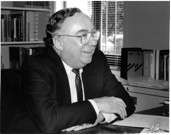Leonard Searle
Leonard Searle (October 23, 1930 – July 2, 2010) was an English-born American astronomer who worked on theories of the Big Bang. He was born in Mitcham, a suburb of London, and studied at St Andrews in Scotland and Princeton in New Jersey.[1] After receiving his doctorate he started working at the University of Toronto in 1953, leaving in 1960 for the California Institute of Technology. In 1963 he moved to Australia for a post at the Mount Stromlo Observatory, before settling finally at the Carnegie observatories in Pasadena, California, in 1968. In 1989 he became director of the Carnegie Observatories.[2]

Searle's work focused on the conditions of the Big Bang and the early universe, and on the formation of heavy elements in stars.[1] One of his main fields of study was the abundance of helium in the early universe. With Wallace Sargent he developed a model to calculate the hydrogen-to-helium composition of galaxies.[2] As director of the Carnegie Observatories, he was also central to the construction of the Las Campanas Observatory in Chile, considered the best natural imaging telescopes in the world.[1] Searle married Eleanor Millard, whom he met at Princeton, in 1952. Eleanor Searle, a medieval historian, died in 1999.[2]
References
- Maugh II, Thomas H. (30 July 2010). "Leonard Searle dies at 79; astronomer's work provided key information on the Big Bang". Los Angeles Times. Retrieved 1 August 2010.
- "The Carnegie Observatories - Galaxy Formation Pioneer Dr Leonard Searle Dies". Carnegie Institution for Science. Archived from the original on 15 August 2016. Retrieved 1 August 2010.